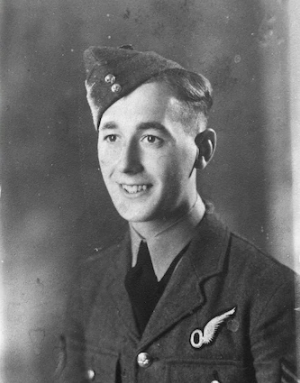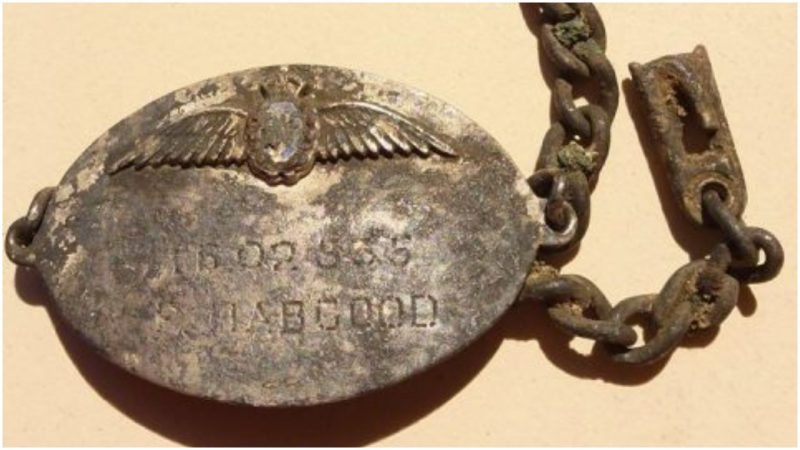The personal bracelet an RAF bombardier killed during the Second World War has finally been returned to his family after almost 80 years. The bracelet, which was once owned by Sergeant Frederic Harold Habgood, was discovered at the Nazi concentration camp where he was hanged.
Sergeant Habgood was just 21 at the time of his death. He served in the RAF in 1944 after spending 1943 training in Canada. After being attacked by a German night fighter Habgood bailed out of his aircraft and was eventually captured by the Gestapo.
When he died, he was wearing a bracelet given to him by his aunt and uncle. It was inscribed with his name, service number, and RAF wings. After receiving news of his death, Habgood’s family assumed the bracelet had been stolen by the Nazis, or simply lost to time.
His death took a heavy toll on the family and they rarely spoke about the traumatic experience.
“Growing up, all we knew was that Freddie had been killed during the war,” says Marilyn Corrigan, Habgood’s niece. “It wasn’t until I was quite a bit older that I realized he had actually been executed.”
“It was never really spoken about. Certainly, my father didn’t want to talk about it.”
Today, Natzweiler-Struthof concentration camp, where Habgood was murdered, serves as a warning for future generations. In 2018 a young girl was watering flowers at the camp when she noticed a shiny piece of metal glinting in the soil.
The piece of metal was identified as Habgood’s bracelet.
An emotional ceremony took place at the camp yesterday, at which Marilyn and her brother Paul Habgood were given the long-lost piece of jewelry.
“From the first time we visited Ottrot before we really knew about the concentration camp, finding out about the bracelet, seeing it for the first time and now actually being presented with it and finally bringing it home,
“We now know so much more about what really happened to Freddie and after so many years of not really understanding exactly what occurred after his plane had crashed, we have managed to build up a picture of his final hours,” Marilyn said.
RAF bombardier Sergeant Frederic Harold Habgood

On July 28, 1944, just under 500 Avro Lancaster bombers took off from airbases around eastern England to attack targets in Europe. Habgood was the bombardier on board one of those aircraft, numbered NE164. His target was in Stuttgart, Germany, but NE164 would never make it back to England.
The aircraft’s right wing was set on fire after the bomber was damaged by a German Messerschmitt night fighter. The pilot, Flying Officer Harry Jones, guided the stricken aircraft downwards to the French town of Obernai, crashing landing in a nearby forest.
Jones died in the crash while one of the Lancaster’s gunners died after parachuting out of the aircraft. The five other crew members, including Habgood, parachuted to safety. One of the crew managed to make contact with the French Resistance who helped him return to England.
The other three were captured and survived the war.
Habgood was found by a local woman who offered him shelter and Schnapps. However, the woman’s plan was actually to keep him until she could hand him over to the Gestapo. She asked a fellow local to transport Habgood to the Gestapo Headquarters, but the local refused. Realizing the situation Habgood escaped but was caught that same day by the Gestapo.
The local who refused to help hand him over was later sent to Shirmeck camp.
Habgood was sent to Natzweiler-Struthof concentration camp, where he was immediately executed via hanging and then cremated. He was only 21-years-old.
In 1946 a British military court found five men guilty of Habgood’s murder, two of which were sentenced to death and hanged that same year. Another man involved in the murder committed suicide before his trial began.
More From Us: Bombardier’s Bracelet is Found in The Ash Pit of a Concentration Camp, 74 Years After he Was Executed
While the damage to Habgood’s family was caused long ago, and many have since passed without any consolation of his loss, the return of his bracelet is a small yet meaningful connection to a young man who died almost 80 years ago.
As Paul Habgood said, the family is finally able to “bring Freddie home.”
